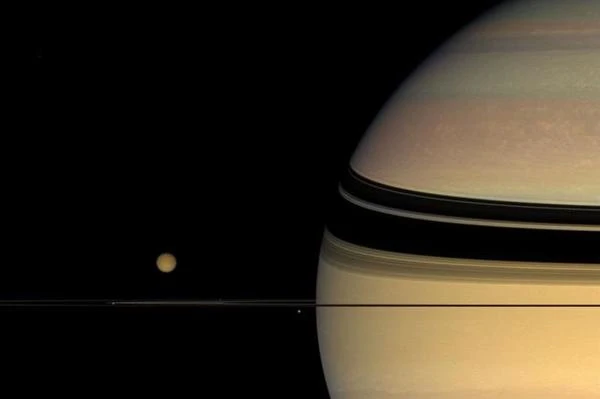
Image: Splendid image of Cassini whose wire of the rings cut in two hemispheres the giant planet of our solar system. Titan flies over here, like a sapphire, the disc of Saturn's rings. Credit: Cassini Imaging Team, SSI, JPL, ESA, NASA
Saturn is a gas giant planet, the second largest in the solar system after Jupiter.
• Size and mass: Saturn has a mass of about 5.69 x 10^26 kg, which is about 95 times that of Earth. Its size is also impressive, with a diameter of 116,460 km, or about 9.5 times that of Earth.
• Atmosphere: Saturn has a thick atmosphere composed mainly of hydrogen (about 96%) and helium (about 3%). There are also traces of methane, ammonia and water in Saturn's atmosphere.
• Rings: Saturn is known for its spectacular ring system, made up of billions of fragments of ice and rock. Saturn's rings are divided into several distinct sections, each named after a letter of the alphabet.
• Great White Spot: Saturn also has a Great White Spot, a cyclonic storm that has been circling Saturn's atmosphere since 2010. The spot is about eight times the size of Earth.
• Magnetosphere: Saturn also has a strong magnetic field, although less strong than that of Jupiter. This magnetic field is responsible for forming a magnetosphere around Saturn, which shields the planet from charged particles in the solar wind.
• Satellites: Saturn has at least 82 known natural satellites, the largest of which are Titan, Rhea, Dione, Tethys, Enceladus and Mimas. Titan is the second largest satellite in the solar system, after Ganymede.
• Rotation: Saturn rotates slowly, with a rotation period of about 10 hours and 45 minutes.
• Orbit: Saturn orbits the Sun at an average distance of about 1.4 billion km, or about 9.5 astronomical units.
• Internal composition: The internal composition of Saturn is similar to that of Jupiter, consisting mainly of hydrogen and helium. The pressure and temperature inside the planet are high enough for these gases to be compressed into a liquid metallic form.
• Polar Hex: Saturn has a polar hexagon visible in the planet's atmosphere at the north pole. This hexagonal structure is formed by circular winds and is visible from observations made by NASA's Cassini spacecraft.
Saturn has been known since antiquity, it is hot (12,000°C in the core) and radiates more energy into space than it receives from the Sun. Learn more.
Definition of the word planet (August 24, 2006):
"A planet is a celestial body which is in orbit around the Sun, which has sufficient mass so that its gravity overcomes the cohesive forces of the solid body and maintains it in hydrostatic equilibrium (spherical shape), and which has eliminated any body moving in a near orbit".